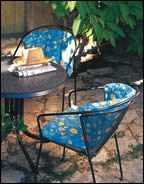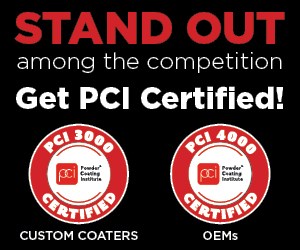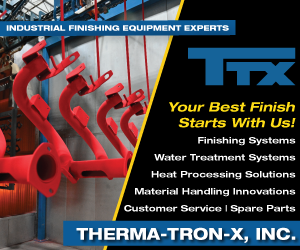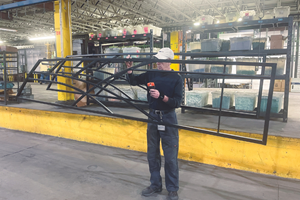Powder Coating Expands Markets & Opportunities In The 21st Century
Powder coating remains the fastest growing industrial finishing method in North America, currently representing about 15% of the total industrial finishing market.
Powder coating remains the fastest growing industrial finishing method in North America, currently representing about 15% of the total industrial finishing market. There are around 5,000 powder coating operations in North America applying powder to a countless array of products for a high quality and durable finish capable of resisting scratches, corrosion, abrasion, chemicals and detergents. Products as small as fountain pen tips and as large as grain harvesting equipment are now powder coated. The powder coating process also maximizes production, cuts costs, improves efficiency and offers maximum compliance with increasingly stringent environmental regulations.
Advantages Of Powder Coating
Environmental advantages have led the way for powder coating conversion in North America. Because powder coating contains no solvents, the process emits negligible, if any, polluting volatile organic compounds into the atmosphere and does not require venting, filtering and solvent recovery systems as is necessary with liquid finishing. Exhaust air from the coating booth can be safely returned to the coating room, and less oven air is exhausted to the outside, making the powder coating process a safer and cleaner finishing alternative and saves considerable energy.
And since it is a dry powder, most powder coating overspray–up to 98%–can be readily retrieved and re-used. The unused powder is reclaimed by a recovery unit and returned to a feed hopper for recirculating through the system. The waste that results is negligible, and can be disposed of easily and economically.
Greater efficiency is achieved because powder coating requires no drying or flash-off time, so parts can be racked closer together on a conveyor, and more parts can be coated automatically. Powder coating does not run, drip or sag, and this results in significantly lower reject rates.
While these environmental and operational advantages translate to economical advantages, there are additional cost savings with powder coating, which include minimum operator training and supervision for a powder line, employee preference in working with dry powder over liquid paints because of powder’s lack of fumes, reduced housekeeping problems and minimum contamination of clothing. Also, compliance with federal and state regulations is easier, which saves both time and money.
How Powder Coating Works
Powder coating was introduced in North America more than 40 years ago. It is a dry finishing process, using finely ground particles of pigment and resin that are electrostatically charged and sprayed onto electrically grounded parts. The charged powder particles adhere to the parts and are held there until melted and fused into a smooth coating in a curing oven.
Powder Materials
There are two types of powder coatings: thermoplastic and thermosetting. A thermoplastic powder coating melts and flows when heat is applied, but continues to have the same chemical composition once it cools and solidifies.
Thermosetting powder coatings also melt when exposed to heat. After they flow into a uniform thin layer, however, they chemically cross-link with themselves or with other reactive components. The final coating has a different chemical structure than the basic resin, is heat stable and, unlike thermoplastic powder after curing, will not soften back to the liquid phase when reheated.
Pretreatment
Parts to be powder coated are first exposed to a pretreatment operation to ensure that the surface to be coated is clean and free of grease, dust, rust, etc. The pretreatment process is normally conducted in a series of spray chambers where alkaline cleaners, iron or zinc conversion coatings and rinses are applied. Parts of various size or shape may be cleaned with pressurized and/or heated sprays. Dip tanks may be used instead of spray for some applications. Powder coating lines usually incorporate a phosphate application step that adds corrosion protection and improves the adhesion of the coating.
Pretreatments most often used in powder coating are iron phosphate for steel, zinc phosphate for galvanized or steel substrates and chrome phosphate for aluminum substrates. After the parts have passed through all of the pretreatment steps, they are normally dried in a low temperature dry-off oven. After drying, the parts are ready to be powder coated.
New methods in pretreatment have recently been introduced. Improved alkaline metal iron phosphates plus non-chrome seal systems yield improved corrosion protection on steel, galvanized steel and aluminum alloys. Improved nickel-free zinc phosphates avoid the environmental issues related to use and disposal. New dry-in-place pretreatment products–as a seal rinse over an alkaline metal phosphate or as the sole pretreatment to a clean metal substrate–can reduce the number of stages required before powder coating application. And the use of an autodeposition coating as a pretreatment or primer for powder coating eliminates phosphates, has a low temperature curing requirement at 210 F, and is an environmentally friendly pretreatment option. The powder applied after this pretreatment method must also be cured at similarly low temperatures under 250 F in order to maintain its performance, and works well with UV-curable powder coatings.
Powder Application
The powder coating application process uses four types of equipment: the powder delivery system, the electrostatic spray gun system, the spray booth and the powder recovery system.
The delivery system consists of a powder storage container or feed hopper and a pumping device that transports a mixture of powder and air into hoses or feed tubes. Some feed hoppers vibrate to help prevent clogging or clumping of powders prior to entry into the transport lines.
Electrostatic powder spray guns direct the flow of powder; control the pattern size, shape, and density of the spray as it is released from the gun; charge the powder being sprayed and control the deposition rate and location of powder on the target. Spray guns are either manual (hand-held) or automatic (mounted to a fixed stand or gun mover).
The most common application method is with “corona charging” guns that generate a high-voltage, low-amperage electrostatic field between the electrode and the product being coated. Powder particles that pass through the ionized electrostatic field at the tip of the electrode become charged and are deposited on the electrically grounded surface of the part.
The powder particles in a “tribocharging” electric gun receive an electrostatic charge as a result of friction that occurs when powder particles rub a solid insulator or conductor inside the gun. The resulting charge is accomplished by stripping electrons from the powder, producing positively charged powder. Because there is no actual electrostatic field, the charged particles of powder migrate toward the grounded part and are free to deposit in an even layer over the entire surface of the part and deposition into recesses is improved.
The powder bell–or powder turbine, is another application method–where the turbine rotates an enclosed powder bell head. Powder is delivered to the bell head and ejected by centrifugal force. The powder passes through an electric field between the rotating bell head or an externally mounted electrode and either the grounded object to be coated or a counter electrode positioned behind the bell’s head. It is then is subjected to the normal corona charging mechanism, ejecting the powder evenly over a large area.
The tribo disk features a non-rotating disk positioned vertically inside an Wloop, and parts are conveyed through the loop as the disk oscillates up and down, applying overlapping layers of powder coating on the parts’ surface. The tribostatic charging method is employed, and the disk forms a uniform, horizontal spray pattern of about 2.5 feet in diameter.
The use of oscillators, reciprocators and robots to control spray equipment reduces labor costs and provides more consistent coverage. Gun triggering, (triggering the gun on and off using a device that can sense when the target is properly positioned) will reduce overspray material, which translates into lower material and maintenance costs.
The powder spray booth is designed to safely contain the powder so that overspray cannot migrate into other areas. The entrance and exit openings must be properly sized to allow clearance of the largest product part. The airflow through the booth must be sufficient to channel all overspray to the recovery system, but not so forceful that it disrupts the powder deposition and retention on the part. If one booth is to be used for multiple colors, the booth interior should be free of narrow crevices, seams, and irregular surfaces that would be difficult to clean, especially if collected overspray is to be recycled.
The batch booth is designed for coating individual parts or groups of parts that are handled using batch production methods. Conveyorized booths are designed for the continuous coating of the product on an overhead conveyor line in medium to high production operations, coating parts of various shapes and sizes.
The powder recovery systems make use of either cyclones or cartridge filter modules that can be dedicated to each color and easily removed and replaced when a color change is needed. Equipment manufacturers have made significant design improvements in powder spray booths that both allow color changes to be made with a minimal downtime and allow the recovery of a high percentage of the overspray, which can raise powder use to nearly 100%.
Curing
There are four basic methods normally used in the curing of powder coated parts: convection, infrared, a combination of the two and ultraviolet curing used with heat-sensitive substrates. (Ultraviolet curing is further discussed in related stories in this section.) Convection ovens can be either gas or electric. Air is heated and circulated inside the oven around the powder coated parts. The parts attain the temperature within the oven.
Infrared (IR) ovens using either gas or electricity as their energy source emit radiation in the IR wavelength band. This radiated energy is absorbed by the powder and the substrate immediately below the powder, but the entire part need not be heated to cure temperature. This allows a relatively rapid heat rise causing the powder to flow and cure when exposed for a sufficient time.
Combination ovens generally use IR as the first zone to melt the powder quickly. The following convection zone can then use rather high velocity currents since there is no danger of disturbing the powder. These higher velocities permit faster heat transfer and a shorter cure time.
Markets And Uses
Powder coatings are now used on hundreds of parts and products, with ongoing technological breakthroughs in powder materials and application processes continually expanding the list. Almost all metal patio furniture is currently powder coated, along with the majority of all metal display racks, store shelving and shop fixtures.
The appliance industry is the largest single market sector for thermosetting powders. Current uses include refrigerators, washer tops and lids, dryer drums, range housings, dishwashers, microwave oven cavities and freezer cabinets. As porcelain-replacement powders become further developed, the appliance market will continue to grow.
The automotive industry currently uses powder coatings on wheels, bumpers, hubcaps, door handles, decorative trim, radiators, engine blocks and numerous under-the-hood parts and components. The most dramatic development in the auto industry in recent years is the use of clear powder coatings over automotive exterior basecoats. These powder clearcoats are now being applied by some European auto manufacturers such as BMW and Volvo. Powder is being used for the exterior body intermediate coat–the primer-surfacer–on select models of Lincoln, Chevrolet, Daimler-Chrysler, Mercedes-Benz, Dodge and Jeep.
The architectural and building markets powder coat aluminum extrusions used on frames for windows and doors, building facades, fixtures, and modular furniture. In Europe, powder coatings predominate in the architectural market, and the North American powder coating industry is working to expand powder coating use in the architectural and building market. Because of the excellent durability of powder coatings, many highway and building projects use them on light poles, guard rails, posts and fencing.
There are everyday uses for powder coated products such as lighting fixtures, antennas and electrical components. Farmers have powder coated tractors and agricultural equipment. Fitness buffs use bicycles, ski poles and bindings, camping equipment, golf clubs and golf carts, exercise equipment, and snowmobiles that are powder coated. Office workers use powder coated file drawers, computer cabinets, laptop computers, cell phones, pens and mechanical pencils, and furniture. Parents have powder coated baby strollers, cribs, playpens, car safety seats, metal toys and wagons. In addition to various appliances, homeowners have lawn mowers, snowblowers, barbecue grills, patio furniture, garden tools, bird feeders and pet cages, bathroom scales, toolboxes and fire extinguishers that benefit from a powder coated finish.
And new applications for powder coating are increasing all the time, with new developments in powder coating materials and new methods of applying powder leading to uses that were unimaginable just a few years ago. (See related articles in this section.)
Related Content
Powder Coating Overcomes Post Forming
Six Sigma methodology, open communication, and collaboration produce results for leading boat manufacturer.
Read MoreAn Altruistic Growth Strategy Puts People First
Professional Plating emphasizes investing in its team and fostering a supportive environment on the shop floor.
Read MoreCalculating the Cost of Powder Coating
How can you calculate the cost of powder coating a component if you only know its surface area? Powder coating expert Rodger Talbert has the answer.
Read MoreReduced, Reused and Recycled Powder Coatings Are the Future
They say necessity is the mother of invention, and with millions of pounds of powder coating going into landfills a year, these two companies have found novel approaches to dealing with this waste stream.
Read MoreRead Next
A ‘Clean’ Agenda Offers Unique Presentations in Chicago
The 2024 Parts Cleaning Conference, co-located with the International Manufacturing Technology Show, includes presentations by several speakers who are new to the conference and topics that have not been covered in past editions of this event.
Read MoreEducation Bringing Cleaning to Machining
Debuting new speakers and cleaning technology content during this half-day workshop co-located with IMTS 2024.
Read MoreDelivering Increased Benefits to Greenhouse Films
Baystar's Borstar technology is helping customers deliver better, more reliable production methods to greenhouse agriculture.
Read More























